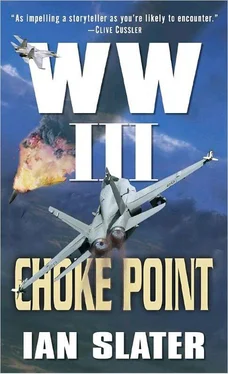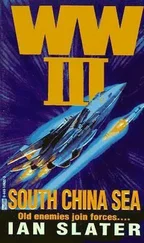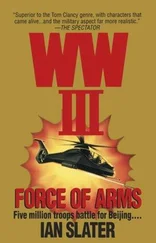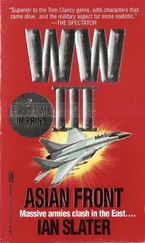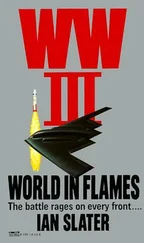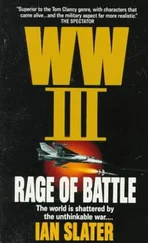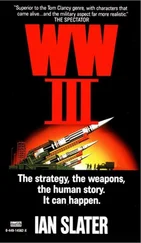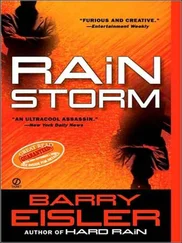A beeping invaded the low hum of the CIC, John Cuso hearing, “We have a leaker,” one of the electronic warfare officers informing CIC that an unknown aircraft coming out of the northeast quadrant had violated the battle group’s air space. Computer analysis vectors leading to and from the X blipping on the powder blue screen put the bogey’s speed at Mach 1.4. The McCain ’s Combat Air Patrol of four F-18s was flying at thirty thousand feet, already on an intercept course, the intruder up to now having evaded the McCain ’s battle group’s radar by flying at plus or minus two hundred feet above the sea.
“A skimmer?” inquired Cuso calmly, confident that the McCain ’s Combat Air Patrol, on strict radio silence, would be within visual contact in ten minutes.
“Don’t think it’s a skimmer, sir,” answered an EWO, his computers, together with the target acquisition system, telling him the bogey was too fast for an enemy cruise missile, and an intermittent profile of the cross-sectional area, glimpsed by the carrier’s radar, was too large for faster pilotless vehicles.
“How sure are you?” Crowley pressed the electronic warfare officer.
“That it’s an aircraft, not a skimmer? Ninety percent sure, sir.”
Crowley was tempted to break radio silence and take the consensus of his two Aegis cruisers and the destroyers that made up the McCain ’s protective screen, but his natural curiosity was sidelined by his responsibility to deny any potential adversary the exact position of his battle group. Cuso knew the admiral’s decision was probably at odds with the White House’s wish to let Beijing and Taipei know that the “police” were coming, as it were, to stop the fighting. But with the disastrous events that had sunk three of the U.S. Navy’s ships in the Strait of Juan de Fuca, Cuso favored his boss’s caution. Both men, like the six thousand people in McCain plus the thousands more manning her battle group, had personally known many of those killed and missing. Besides, in five minutes McCain ’s CAP would establish if the bogey was a hostile, and if so, shoot it down. And if the CAP didn’t make the kill — though why, Crowley couldn’t imagine — then either the battle group’s formidable Aegis cruisers, Arleigh Burke destroyers, or the duo of fast attack submarines most certainly would.
Typhoon Jane’s winds had increased speed to 125 miles an hour, and Admiral Crowley, returning to Primary Flight Control, six stories above the flight deck, heard the typhoon’s advance gusts howling around the carrier’s superstructure as the huge airfield kept plowing into the Taiwan Strait at 32 knots. The planes parked on the flight deck were chained down as tightly as those in the hangar deck, the huge, gray ship trembling in its lower regions from the reverberations of its four nuclear-generated steam engines, which were driving the four massive shafts of the carrier and all aboard her into harm’s way.
The four Super Hornets of McCain ’s Combat Air Patrol peeled off high above the bogey. It was still flying so low that as Lieutenant Commander Chipper Armstrong’s F-18 Super Hornet broke through the thick gray nimbostratus that was preceding Typhoon Jane by 230 miles, he made visual contact with the speck moving southeast toward the carrier’s battle group. The blip on his radar and its concomitant altitude reading seemed at odds, however. His radar was telling him the bogey was 150 feet above the deck, or sea level, his eyes looking through the sun visor of his helmet telling his brain that the unidentified craft was within arm’s reach of the wrinkled gray sea. In the backseat of the Hornet, Chipper’s RIO — Radar Intercept Officer “Eagle” Evans, so-called because of his exceptional daytime vision — flicked on his digital reconnaissance camera, selecting zoom and link-up to Chipper’s right-hand digital display indicator so that Chipper could now receive real-time images of the bogey.
“It’s an ROC,” said Evans. “Taiwanese. An F-16. That’s a Fighting Falcon to you.”
“What the hell’s it doing here?” asked Chipper.
“Lost his way?” proffered Evans. “Check out its left wing’s flaperons.”
“I see ’em,” said Chipper Armstrong, his eyes following the line of dime-size bullet holes that extended all the way forward of the Fighting Falcon’s rear ventral fins to the leading edge of the fighter’s cropped delta wing and up to the plane’s big telltale bubble cockpit. The Hornet’s zoom caught a blinding flash from the Falcon’s bubble, which was the “gold” sprayed inside to stealth the aircraft from radar waves.
“That gold just freaked out the zoom,” RIO Evans commented, the presence of the pneumonic gray stratus doing little to reduce the gold bubble effect. “I think his nav equipment’s shot to hell, Chipper.”
“Could be,” responded Armstrong. “From those holes forward of his ventrals, I’d say he took a full burst in the kidneys.”
“Can you see him?” asked Evans.
“Negative, but it’s the damned gold cockpit.”
Armstrong moved the stick hard left to give the Hornet’s disc camera a less direct angle of approach, the Falcon looking to Armstrong as if it was still on a straight, perhaps auto-controlled flight path. His assumption was confirmed by the Hornet’s left digital display, telling him the Falcon was 108 feet above the sea and three miles below the McCain ’s CAP, its speed 914 mph. Armstrong’s four Super Hornets, descending at Mach 1.1, simultaneously moved out of their line-abreast combat pairs into the more open fluid four formation, its two leaders — Armstrong on the left, “Rhino” Manowski on his right, scanning forward, each of their wingmen behind them and off to the side, their responsibility being to watch fore and aft of the four Hornets’ formation.
Chipper Armstrong and his RIO, on the front left of the formation, were ten thousand feet from their CAP’s right-hand leader and his RIO. The distance between each leader Hornet and wingman, however, was much closer, this spread between leader and minder no more than a thousand feet. This left Chipper Armstrong and Rhino Manowski as the front pair of the fluid four formation, freer to concentrate on the ROC Taiwanese Fighting Falcon that seemed devoid of human guidance.
“He’s moving,” announced Eagle Evans, Chipper’s RIO, Chipper fighting a sudden wind shear that was shooting up in excess of 200 knots per hour. It violently buffeted Armstrong and Evans’s Hornet for four seconds, the strength of the phantom’s “upblast” no doubt having enveloped the Fighting Falcon with such force that Armstrong and his wingman aft left of him came to the same conclusion — that any movement they’d glimpsed in the Falcon’s cockpit almost certainly had been due to the ROC pilot’s body being shaken by the hammerlike blows of the wind shear column colliding with the Falcon’s air drag, putting the Falcon momentarily into “bone-shake” mode before its autopilot computer effected flap and “Hi” stabilizer corrections.
“I dunno, Chipper,” said Evans hesitantly. He thought he’d seen the ROC pilot move forward from the Falcon’s maximum thirty-degree recline position. But he wasn’t sure, which meant he wasn’t sure whether the pilot was alive.
Evans’s hesitation was a manifestation of the doubt born the day after he and Armstrong had completed their six-week-long cadet Aviation Preflight Indoctrination course at Pensacola, Florida. Both men, along with dozens of other hopefuls, passed their rigorous Aerodynamics, Survival, Physiology, Escape, and Navigation training tests. But Evans learned that while he’d been rated “above average,” he’d flunked the test for Navy aviator nighttime vision. At twenty-three, he saw it as a colossal personal failure, despite the instructor’s slap-on-the-back advice that the responsibility in the backseat was huge. “Damn pilot can’t do much if he doesn’t know where the hell he is, Evans.”
Читать дальше
